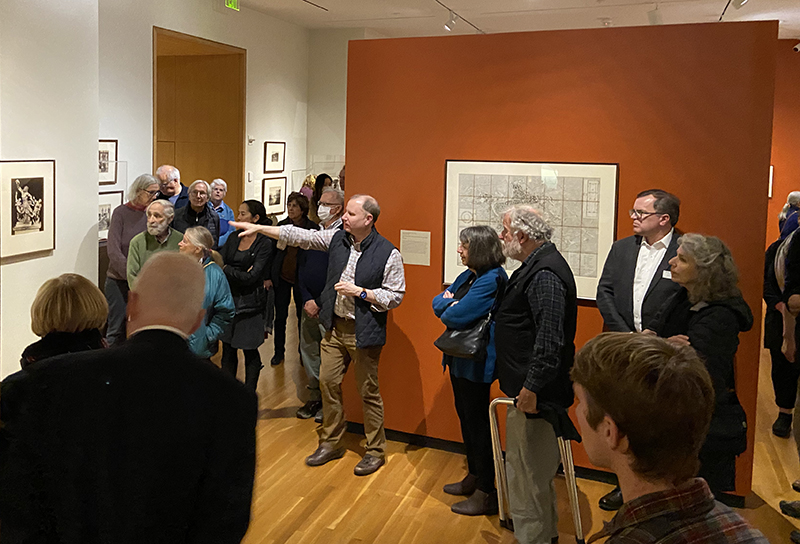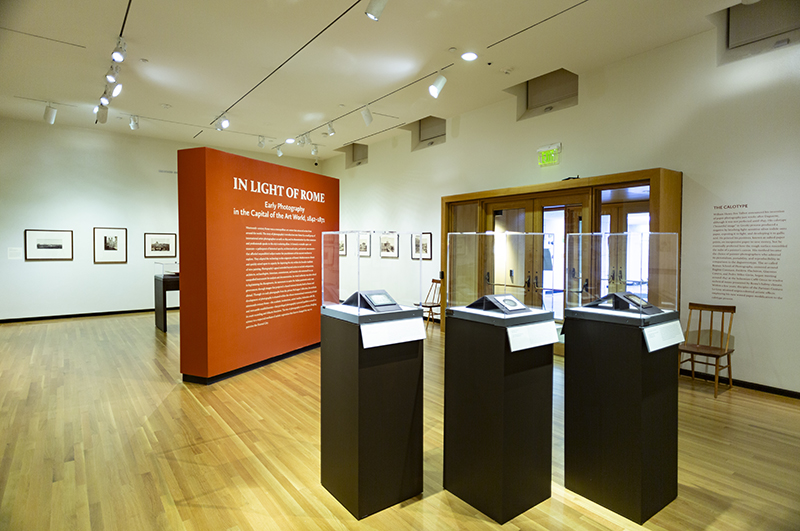Conversation with the Curator
By Bowdoin College Museum of Art
John McGuigan leads a tour of the exhibition in December 2022.
In Light of Rome: Early Photography in the Capital of the Art World, 1842–1871 opened at the BCMA in December and has already garnered wide notice. The exhibition explores—for the first time in the United States—the role that Rome played in the aesthetic development of photography. It situates early photography within the vibrant transnational community of mid-century Rome—the academic institutions, artists’ studios, bohemian caffè life, and mercantile establishments—that privileged photography’s pictorial effects as much as its overt recording and didactic functions. Featuring more than 100 vintage photographs, it traces the rise of photography from a fledgling science to a legitimate medium of artistic expression that forever changed the way we perceive the Eternal City. The exhibition remains on view through June 4, 2023.
Recently BCMA co-director Frank Goodyear spoke with the exhibition’s lead curator John F. McGuigan.
FG: What differentiates early photography in Rome from work in other major artistic centers?
JM: Unlike most cities, Rome is an explorable open-air museum with a palimpsest of over three thousand years of history and culture that has drawn people from all over the world for millennia to study, learn, and thrive—architects, archaeologists, painters, poets, sculptors, students, tourists, and writers. During the eighteenth and nineteenth centuries, a Roman sojourn was considered an essential component for any portfolio or education (the ultimate finishing school, as it were), and each person who visited or lived there contributed their unique cultural perspective and life experience to the fabric of the city’s cosmopolitan art circles. This trip was especially true for foreign photographers who typically came from northern Europe and worked in colder, wetter, and greyer cities like Berlin, London, or Paris, who therefore found it difficult to navigate the unique southern light and climate in Italy, whose warm and sunny atmosphere required new and different technical approaches and chemical processes to produce successful images. Rome was, in comparison, a much smaller city and the small group of established photographers congregated at the legendary Caffè Greco, where artists and writers had been gathering since 1760 (including Bowdoin’s very own Hawthorne and Longfellow). Here this transnational cohort, passionate about perfecting and advancing photography to an equal branch of the fine arts, welcomed all newcomers and brought them up to speed on the latest technical advances, as well as providing hints and tips on the best places to shoot. It was this congenial environment, in my opinion, that existed nowhere else in the world, that made Rome truly special.
 FG: Who were some of the leading photographers in the decade after photography’s introduction, and what subjects most interested them?
FG: Who were some of the leading photographers in the decade after photography’s introduction, and what subjects most interested them?
JM: During this early period (the decade after the daguerreotype was revealed to the world in January 1839), photography was pioneered by an unlikely hodgepodge of artists, archaeologists, opticians, and chemists. Although some painters were initially skeptical about the invention, dismissing it as a mere mechanical process devoid of creativity, the artist and architectural historian Joseph-Philibert Girault de Prangey (who likely learned Daguerre’s process firsthand in Paris) was early to recognize its potential and made it his preferred method for documenting the ancient architecture and cityscape in minute detail during his trip to Rome in 1842. Opticians and chemists were particularly adept at assimilating and implementing the various scientific treatises that were being regularly published, and they had the skills necessary to construct their own equipment, especially camera lenses, before they were commercially available to the public. The Parisian optician and daguerreotypist Noël-Marie-Paymal Lerebours also commissioned dozens of photographers from around the globe, including the Roman optician Lorenzo Suscipj in 1840, to execute a series of views from all over the city for his travel book Excursions daguerriennes: Vues et monuments les plus remarquables du globe. Practicing photography in the field was quite laborious and cumbersome, and, due to required exposure times of upwards of twenty minutes, it was extremely difficult to capture people, who would otherwise appear blurry or ghost-like. However, with the advent of better lenses and chemical agents between 1842 and 1845, exposure times were reduced to around twenty seconds. This breakthrough allowed for portrait photography, which became all the rage, and was soon mastered not only by Suscipj, who had a purpose-built studio constructed, but also for dozens of itinerant photographers such as Edgar Adolphe from Paris who capitalized on the new demand. By 1845, paper photography, known as calotypes, appeared with more frequency, and since this process produced a negative from which multiple positives could be made, it soon usurped the daguerreotype which could only produce one positive. The proliferation of the calotype, quickly adopted by fine artists, soon gave birth to an internationally recognized group, the Roman School of Photography, at the head of which stood a number of prominent transnational artists such as Giacomo Caneva, Eugène Constant, Frédéric Flachéron, and Pedro Téllez Girón.
FG: How did photographers’ work in Rome compare with earlier representations of the city?
JM: For the first time in history, the daguerreotype and calotype allowed one to capture and preserve Nature with supreme accuracy, devoid of artifice or exaggeration. The earliest photographers were reluctant to move away from the traditional visual lexicon that had been established and rigidly followed for centuries in Rome, largely disseminated through print culture to every corner of the globe. Because most popular engravers, such as Piranesi or Vasi, often enlarged their subjects or altered their perspectives to achieve maximum legibility and compositional impact, early photographers felt it incumbent to depict the exact same viewpoints in order to give their audience an easy point of reference, thus engaging in direct competition with their predecessors in order to prove the medium’s supremacy for truth. Once this point had been made, artists and consumers of material culture readily embraced the endless possibilities that this invention afforded, which allowed photographers more freedom to create unique views and express their individuality which, to my mind, reached its apotheosis under the Italian Adriano de Bonis, someone well represented in the exhibition.
FG: Did photographers explicitly document the political and social revolutions that were happening in the years before Italian unification?
JM: One of the very first photographers to document any theater of war was the Italian Stefano Lecchi, unfortunately not represented in our exhibition but illustrated in the catalogue. After the French army intervened and defeated the forces of the short-lived Roman Republic of 1849, restoring Pope Pius IX to power, Lecchi captured the destruction from artillery and mortars to country villas that surrounded Rome that had been used as defensive positions by the doomed soldiers of the republic. The propagandistic impact these images afforded (and engravings made after them) was certainly realized all over the world, especially as a projection of both French and Papal military power. It was again brought into use eighteen years later when the Vatican authorized two Roman photographers, Gioacchino Altobelli and Paolo Francesco d’Alessandri, to document the advanced state of preparedness of both the French and Papal armies against any attack by Italian troops who wished to secure Rome as the final piece for Italian unification. In their own right, many progressive photographers resident in Rome, who supported the Risorgimento (the quest for Italian unification), were restricted in the rigidly controlled and governed city which was occupied by French troops between 1849 and 1870. They had to be more subtle in their subject matter, and chose to select symbolic representations of the glory of the Eternal City’s past, easily recognizable to sympathetic audiences, who were eager to see the city restored as Roma Caput Mundi, or Rome, capital of the world.